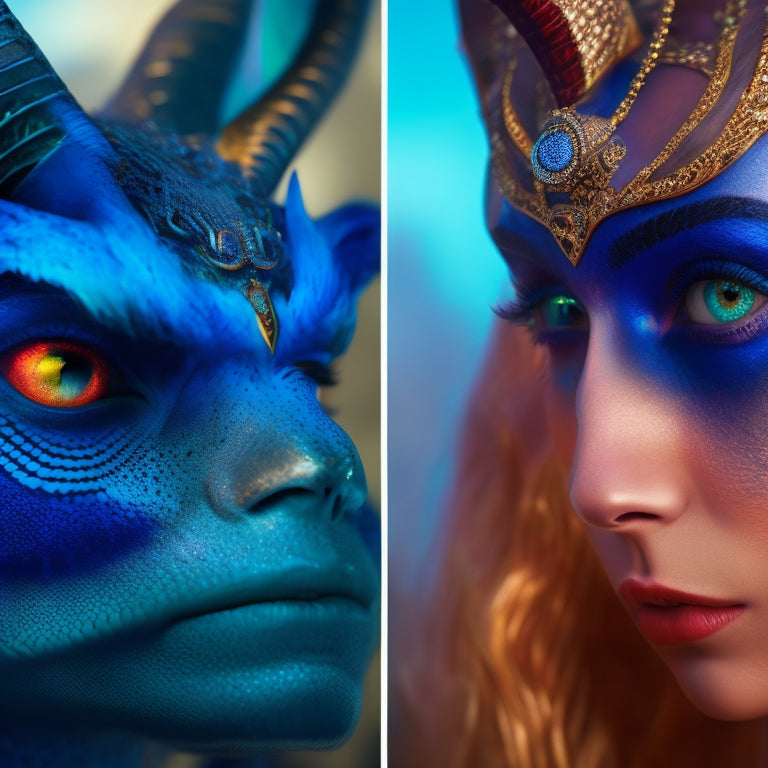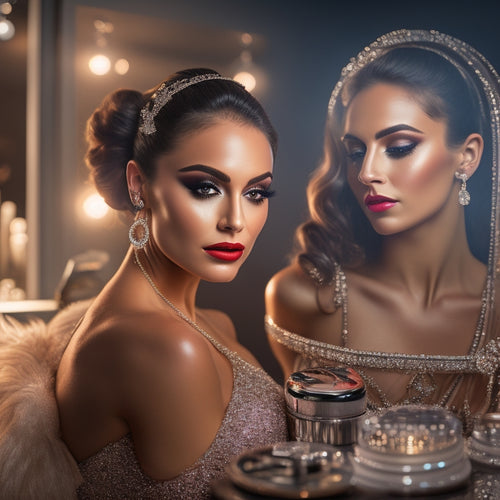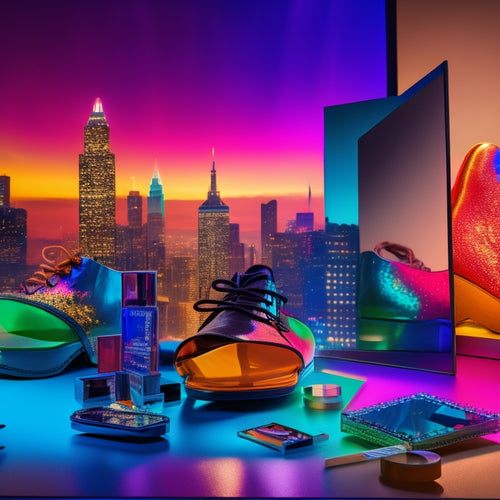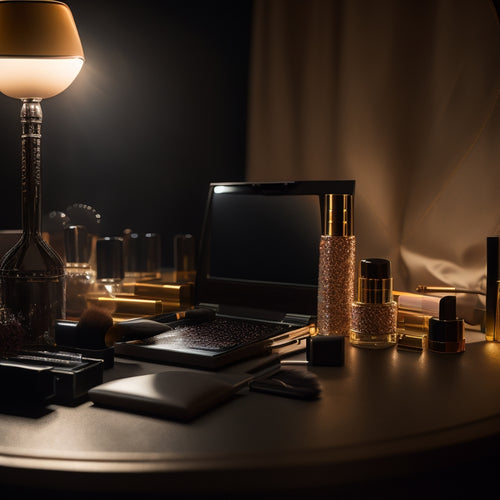
7 Essential Digital Makeup Tutorials for Costume Design
Share
You're about to discover the secrets to enhancing your costume design with digital makeup techniques. From fantasy creatures to period-inspired looks, mastering these essential tutorials will elevate your art to the next level. Learn to craft mythical avatars with gradient maps, master Victorian elegance, and create realistic skin tones with precision. Then, immerse yourself in transformative character makeup, airbrushing, and special effects for film. With these 7 tutorials, you'll be well on your way to creating breathtaking designs that transport audiences to new worlds. The art of digital makeup awaits - are you prepared to explore its full potential?
Key Takeaways
• Master blood simulation tutorials to create realistic blood textures, flows, and splatters for film and costume design.
• Learn wound aging techniques to create realistic wound progression from fresh cuts to festering sores.
• Integrate digital prosthetics seamlessly with live-action footage using prosthetic integration tutorials.
• Create makeup looks that complement and enhance the overall costume with costume design tutorials.
• Achieve specific special effects like scars, bruises, and burns with special effects makeup tutorials.
Fantasy Creature Makeup Designs
When conjuring fantasy creatures, you'll often find that the most mesmerizing ones boast intricate, otherworldly features that transport audiences to worlds both magical and terrifying. In the domain of digital makeup tutorials, crafting these mythical avatars requires a deep understanding of texture, color, and light.
To bring your fantasy creatures to life, start by designing fiery scales that shimmer and glimmer in the virtual light. Use gradient maps to achieve an iridescent sheen, and experiment with normal maps to add depth and dimension to your scales.
Next, focus on the finer details - the wispy tendrils of smoke curling from a dragon's nostrils, the glittering gemstones embedded in a mermaid's tail, or the delicate, almost translucent wings of a fairy. These subtle touches can elevate your design from mere mortal to mythical avatar.
Period-Inspired Historical Looks
As you explore the world of period-inspired historical looks, you'll find yourself navigating a rich tapestry of eras, each with its unique aesthetic, from the soft, porcelain complexions of Victorian-era ladies to the bold, crimson lips of 1920s flappers.
To master these looks, you'll need to immerse yourself in the nuances of each era's beauty standards. For a Victorian elegance, focus on enhancing natural features with subtle, earthy tones and defined brows. Create a flawless base with a sheer foundation, and accentuate the eyes with soft, smoky shadows.
To evoke Edwardian charm, opt for a more dramatic, glamorous look, with bold eyes, defined cheekbones, and a subtle, rosy glow. Study the iconic beauty icons of each era, from Queen Victoria to Louise Brooks, to grasp the essence of their style.
With practice and patience, you'll be able to transport your audience to a bygone era, where elegance and sophistication reign supreme.
Building Prosthetics From Scratch
By starting on this creative path, you'll discover the importance of silicone molding, which allows for intricate designs and realistic textures.
To achieve the desired shape and form, you'll need to master foam carving techniques, carefully whittling away excess material to reveal the underlying structure.
Material selection is also vital, as you'll need to choose the right combination of materials to achieve the desired look and feel.
Sculpting techniques will come into play as you refine the prosthetic's surface, adding subtle nuances and details that bring your character to life.
Finally, you'll need to take into account adhesive options to guarantee a secure and comfortable fit.
With patience, practice, and attention to detail, you'll be able to craft prosthetics that transport your audience to new worlds and dimensions.
Airbrushing for Smooth Finishes
As you prepare to airbrush your costume design, you'll need to master the basics of airbrushing, including proper gun handling and thinning your paints to achieve a smooth, even finish.
You'll learn how to build up layers of color to create a seamless, realistic look, and how to troubleshoot common issues like texture and unevenness.
Basic Airbrush Techniques
You'll achieve smooth, high-definition finishes in your costume design by mastering the fundamental airbrush techniques that create seamless connections between colors and textures. To get started, it is crucial to understand the basics of stenciling and brush control. Stenciling basics involve using masks or guides to create crisp, defined edges and patterns. This technique is perfect for creating intricate designs, logos, or textures.
| Technique | Description | Tips |
|---|---|---|
| Stenciling | Use masks or guides to create crisp edges | Use low-pressure and thin coats to avoid buildup |
| Brush Control | Regulate air pressure and brush distance | Practice varying pressure and distance for smooth transitions |
| Layering | Build up thin coats for seamless blends | Allow each layer to dry before adding more makeup |
Achieving Smooth Surfaces
With your airbrush skills refined through stenciling and brush control, now focus on honing your technique to achieve flawless, high-definition surfaces that elevate your costume design.
It's time to master the art of smooth surfaces, where every detail matters. To begin, make sure a meticulous Surface Prep, ensuring that your base layer is even and blemish-free. This is vital, as any imperfections will be amplified once you start airbrushing.
Next, adjust your airbrush settings to achieve a fine, mist-like spray. Hold the airbrush at a 90-degree angle, about 6-8 inches away from the surface. Move in smooth, gentle strokes, maintaining consistent pressure to prevent unevenness.
Focus on covering small areas at a time, gradually building up to larger sections. As you work, pay attention to the surface texture, adjusting your technique to compensate for any irregularities.
Building Up Layers
How do you plan to achieve a smooth, high-definition finish without building up layers of meticulously applied airbrush strokes? Building up layers is an essential step in airbrushing for smooth finishes, and it requires patience, precision, and practice. To achieve a flawless finish, you need to master the art of layering techniques.
| Layer | Technique | Purpose |
|---|---|---|
| Base layer | Thin, even coat | Establishes uniform tone |
| Mid-layer | Gradual build-up | Adds depth and dimension |
| Top layer | Fine-tuned details | Enhances texture and realism |
| Sealant layer | Protective coat | Locks in the design |
Before you start building up layers, make sure you've prepared the skin with a thorough skin preparation routine. This includes cleansing, moisturizing, and priming the skin to create a smooth canvas for your airbrush artistry. By following these steps and mastering layering techniques, you'll be able to achieve a smooth, high-definition finish that will elevate your costume design to the next level.
Creating Realistic Skin Tones
Accurate skin tone reproduction is essential in digital costume design, as it can make or break the overall believability of a character's appearance. You want your character's skin to look natural, not like they're wearing a mask. To achieve this, you need to understand the complexities of skin undertones.
Here are three key considerations to keep in mind:
-
Identify the undertones: Skin undertones can be warm, cool, or neutral. Warm undertones have a yellow or golden base, while cool undertones have a pink or blue base. Neutral undertones are a mix of both.
-
Match the tone: Use a color picker tool to match the skin tone of your character. Take note of the RGB values and adjust them accordingly.
-
Add depth with layering: Create a layered look by adding subtle variations of the skin tone. This will give your character's skin a more realistic, three-dimensional appearance.
Transformative Character Makeup
You're now ready to take your character's skin tone to the next level by using transformative makeup to convey their personality, social status, or occupation. This is where the art of character development meets makeup artistry.
With transformative makeup, you can create an identity shift that reveals your character's true self. For instance, you can use subtle aging processes, such as fine lines and wrinkles, to convey a character's life experience and wisdom. Alternatively, you can experiment with bold, vibrant colors to evoke a sense of confidence and charisma.
To master transformative makeup, understanding the nuances of color theory and how to blend shades seamlessly is crucial. You'll also need to take into account the character's backstory and personality traits to make sure that the makeup look is authentic and consistent.
Special Effects for Film
When crafting special effects for film, precision and attention to detail are paramount, as a single misstep can shatter the illusion and pull the audience out of the cinematic experience. As a digital makeup artist, you're tasked with creating realistic, thrilling, and often gruesome effects that transport viewers into the world of the film.
To achieve this, you'll need to master techniques like blood simulation and wound aging.
Here are three essential skills to add to your toolkit:
-
Blood simulation: Learn to create realistic blood textures, flows, and splatters that will make your audience cringe. Understand how to manipulate digital fluids to achieve the perfect blood effect.
-
Wound aging: Develop the skills to create realistic wound progression, from fresh cuts to festering sores. This will help you craft a narrative that's both believable and enthralling.
-
Prosthetic integration: Master the art of seamlessly blending digital prosthetics with live-action footage. This will allow you to create characters that are both fantastical and eerily realistic.
Frequently Asked Questions
What Software Is Best for Digital Makeup Design and Planning?
When choosing software for digital makeup design, you'll want tools that offer precision and versatility. Adobe Insights recommends considering industry-standard design tools like Adobe Photoshop and Illustrator, which offer advanced features and seamless collaboration.
How Do I Protect My Skin From Adhesive Prosthetics and Makeup?
Before applying adhesive prosthetics and makeup, you prep your skin with gentle cleansers, then apply barrier creams to prevent irritation. Perform allergy tests, taking into account your skin type, to guarantee a safe and comfortable application experience.
Can I Use Household Items to Create Makeup Effects on a Budget?
You can get creative with DIY alternatives, like using liquid latex and toilet paper to create realistic wounds, or even repurposing household items like coffee grounds for a textured, battle-worn look - all on a budget!
Are There Any Vegan-Friendly Makeup Products for Costume Design?
You'll be thrilled to know that yes, there are amazing vegan-friendly makeup products for costume design! Look for brands offering cruelty-free alternatives and sustainable sourcing, ensuring your creative vision aligns with your values.
Can I Use Digital Makeup Tutorials for Everyday, Non-Costume Makeup?
"Can you imagine waking up with flawless, camera-ready skin every day? You can! Digital makeup tutorials aren't just for costume design; they can also guide you in creating everyday looks with natural enhancements that accentuate your features."
Related Posts
-

Group Dance Makeup Tutorials for Online Success
As you immerse yourself in the world of group dance makeup tutorials, you'll need to master essential makeup techniqu...
-

3 Essential Marketing Tips for Dance Makeup Artists
To shine online and attract new clients, you'll need a solid marketing strategy. First, boost your online visibility ...
-

Get Stage-Ready: Online Dance Makeup Tutorials at Home
You're about to reveal the secrets to a stage-ready dance makeup look from the comfort of your own home. First, ident...


